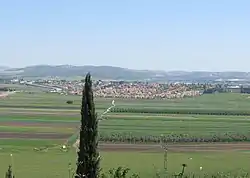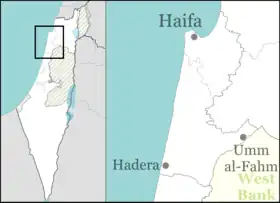Ramat Yishai
Ramat Yishai (Hebrew: רָמַת יִשַּׁי, Jesse's Heights; Arabic: رمات يشاي) is a town in the Northern District of Israel, located on the side of the Haifa–Nazareth road about 4 kilometres (2.5 mi) eastern to Kiryat Tivon. It was previously called Jaida and was inhabited by Arabs. It achieved local council status in 1958. In 2021 it had a population of 8,071; the vast majority of residents are Jewish.
Ramat Yishai
| |
|---|---|
Local council (from 1958) | |
| Hebrew transcription(s) | |
| • ISO 259 | Ramat Yiššay |
 | |
 Ramat Yishai | |
| Coordinates: 32°42′12″N 35°9′54″E | |
| Grid position | 166/234 PAL |
| District | Northern |
| Founded | 1925 |
| Government | |
| • Head of Municipality | Ofer Ben-Eliezer |
| Area | |
| • Total | 2,388 dunams (2.388 km2 or 590 acres) |
| Population (2021)[1] | |
| • Total | 8,071 |
| • Density | 3,400/km2 (8,800/sq mi) |
History
Archaeological remnants have been found from Middle Bronze Age I (a tomb) and the Roman, Byzantine, Umayyad and Abbasid eras. Of particular interest, was a zoomorphic vessel of glass, dating to the Umayyad era.[2] Remains from the Crusades, as well as from the Mamluk era has also been found here.[2]
Ottoman era
During the Ottoman era, a Muslim village called Jeida existed here.[3] It was mentioned in the Ottoman defter for the year 1555-6, named Jayda, located in the Nahiya of Tabariyya of the Liwa of Safad, and with its land designated as Ziamet land.[4]
The village appeared as Geida on the map which Pierre Jacotin compiled in 1799.[5]
In 1859, the village of Jeida was estimated to have 120 inhabitants, and the tillage was 20 feddans.[6] In 1875 Victor Guérin found rock-cut cisterns here.[7][8] In 1881, the PEF's Survey of Western Palestine (SWP) found that Jeida was much like Al-Harithiyah, but with houses of adobe. A spring existed 3/4 of a mile to the west.[6]
A population list from about 1887 showed that Jeida had about 140 inhabitants; all Muslims.[9]
One of the better known buildings in the village is called "the Khan" (caravanserai in Arabic), a 1909 building with surrounding walls. The logo of the village consists of this Ottoman-era building with a palm tree next to it. The town hall flies 2 logo-on-bedsheet flags with this emblem in dark blue on a light blue and a yellow field, respectively.
British Mandate era
In the 1922 census of Palestine conducted by the British Mandate authorities, Jaida had a total population of 327; 324 Muslims and 3 Christians;[10] of which two were Roman Catholics and one was Melkite Catholic.[11]
Ramat Yishai was founded in 1925 when a Zionist organisation purchased 15,000 dunams in Jaida, including the Khan building, from the heirs of the Twsiny family (partners of the Sursuk family of Beirut.) At the time, there were 110 families living in the village.[12][13]
At the time of the 1931 census, Jaida had 29 occupied houses and a population of 77 Jews, 2 Christians, and 33 Muslims; a total of 115.[14]

The land, on the western edge of the Jezreel Valley, which belonged to the village of Jida, was bought by a group of American Zionists in the early 1920s. It was renamed Manor and then Yefe Nof, but was almost deserted after a few years. In 1925, the British philanthropist Yisrael Yehudah "Yishai" Adler saved it from bankruptcy and it was renamed in his honour shortly thereafter.[15] Among the founders of the village were 50 Polish Jewish immigrant families from Łódź and Białystok, who built a textile factory in the village. Yemenite Jews were also among the first residents. They were later joined by Jewish refugees from Romania.[16]
During the Arab Revolt the isolated Jewish population was subject to constant attacks, sniper fire and ambushes from armed militias of local Arabs. On 12 October 1936 Mordechai Feldman was ambushed and killed. On the night of 5 June 1938, armed Arabs attacked the Jews in the village, killed one of the volunteer notrim, Zvi Levine, wounded another, and burned down the textile factory.[17][18]
The population in mid-1937 was estimated as 43 non-Jews and 35 Jews.[19] In the 1945 statistics, Ramat Yishai had 50 residents, all Jewish. It was noted that it was previously called Jeida.[20][21]
State of Israel
Since the 1990s, Ramat Yishai has undergone rapid development. In 2010, the population was estimated at close to 7,000 people, with 1,800 households at the high end of the socioeconomic scale.[16]
Notable residents
- Tzahi Elihen
- Itay Shechter, footballer
References
- "Regional Statistics". Israel Central Bureau of Statistics. Retrieved 22 February 2023.
- Porat, 06/02/2007, Ramat Yishay
- from personal name. In Arabic it means "long-necked", according to Palmer, 1881, p. 109
- Rohde, 1979, p. 82
- Karmon, 1960, p. 163
- Conder and Kitchener, 1881, SWP I, p. 270
- Guérin, 1880, p. 392
- Conder and Kitchener, 1881, SWP I, p. 308
- Schumacher, 1888, p. 175
- Barron, 1923, Table XI, Sub-District of Haifa, p. 33
- Barron, 1923, Table XVI, p. 49
- List of villages sold by Sursocks and their partners to the Zionists since British occupation of Palestine, evidence to the Shaw Commission, 1930
- Davar Newspaper 1926
- Mills, 1932, p. 92
- The Palgrave Dictionary of Anglo-Jewish History, edited by William D. Rubinstein
- Betting on the Trans-Israel Highway The Jerusalem Post
- Zeev Aner (1994) Stories from Eretz Israel,
- Zvi Levine Izkor
- Government of Palestine, Department of Statistics, Village Statistics, Feb. 1938, p.24.
- Government of Palestine, Department of Statistics, 1945, p. 14
- Government of Palestine, Department of Statistics. Village Statistics, April, 1945. Quoted in Hadawi, 1970, p. 49
Bibliography
- Atrash, Walid; Hanna, Butros (2016-04-17). "Ramat Yishay" (128). Hadashot Arkheologiyot – Excavations and Surveys in Israel.
{{cite journal}}: Cite journal requires|journal=(help) - Barron, J.B., ed. (1923). Palestine: Report and General Abstracts of the Census of 1922. Government of Palestine.
- Bisharat, Eyad (2016-03-07). "Ramat Yishay" (128). Hadashot Arkheologiyot – Excavations and Surveys in Israel.
{{cite journal}}: Cite journal requires|journal=(help) - Conder, C.R.; Kitchener, H.H. (1881). The Survey of Western Palestine: Memoirs of the Topography, Orography, Hydrography, and Archaeology. Vol. 1. London: Committee of the Palestine Exploration Fund.
- Daniel, Zohar (2010-06-18). "Ramat Yishay" (122). Hadashot Arkheologiyot – Excavations and Surveys in Israel.
{{cite journal}}: Cite journal requires|journal=(help) - Government of Palestine, Department of Statistics (1945). Village Statistics, April, 1945.
- Guérin, V. (1880). Description Géographique Historique et Archéologique de la Palestine (in French). Vol. 3: Galilee, pt. 1. Paris: L'Imprimerie Nationale.
- Hadawi, S. (1970). Village Statistics of 1945: A Classification of Land and Area ownership in Palestine. Palestine Liberation Organization Research Centre.
- Hanna, Butros (2010-06-18). "Ramat Yishay (South)" (122). Hadashot Arkheologiyot – Excavations and Surveys in Israel.
{{cite journal}}: Cite journal requires|journal=(help) - Hanna, Butros (2012-10-31). "Ramat Yishay (A)" (124). Hadashot Arkheologiyot – Excavations and Surveys in Israel.
{{cite journal}}: Cite journal requires|journal=(help) - Hanna, Butros (2012-10-31). "Ramat Yishay (B)" (124). Hadashot Arkheologiyot – Excavations and Surveys in Israel.
{{cite journal}}: Cite journal requires|journal=(help) - Hanna, Butros (2013-08-26). "Ramat Yishay, Ha-Oren St. (A)" (125). Hadashot Arkheologiyot – Excavations and Surveys in Israel.
{{cite journal}}: Cite journal requires|journal=(help) - Karmon, Y. (1960). "An Analysis of Jacotin's Map of Palestine" (PDF). Israel Exploration Journal. 10 (3, 4): 155–173, 244–253.
- Mills, E., ed. (1932). Census of Palestine 1931. Population of Villages, Towns and Administrative Areas. Jerusalem: Government of Palestine.
- Palmer, E.H. (1881). The Survey of Western Palestine: Arabic and English Name Lists Collected During the Survey by Lieutenants Conder and Kitchener, R. E. Transliterated and Explained by E.H. Palmer. Committee of the Palestine Exploration Fund.
- Porat, Leea (2005-11-13). "Ramat Yishay" (117). Hadashot Arkheologiyot – Excavations and Surveys in Israel.
{{cite journal}}: Cite journal requires|journal=(help) - Porat, Leea (2007-02-06). "Ramat Yishay" (119). Hadashot Arkheologiyot – Excavations and Surveys in Israel.
{{cite journal}}: Cite journal requires|journal=(help) - Rhode, H. (1979). Administration and Population of the Sancak of Safed in the Sixteenth Century. Columbia University.
- Schumacher, G. (1888). "Population list of the Liwa of Akka". Quarterly Statement - Palestine Exploration Fund. 20: 169–191.
- Tepper, Y. (2016-04-14). "Ramat Yishay" (128). Hadashot Arkheologiyot – Excavations and Surveys in Israel.
{{cite journal}}: Cite journal requires|journal=(help)
External links
- Ramat Yishai Official website
- Ramat Yishai on Galil-Net
- Jida, from Dr. Moslih Kanaaneh
- Survey of Western Palestine, Map 5: IAA, Wikimedia commons
.svg.png.webp)